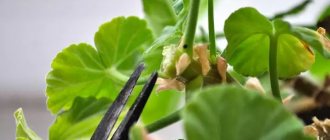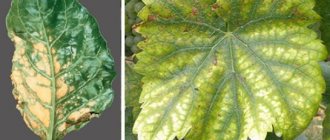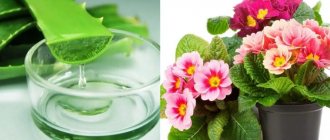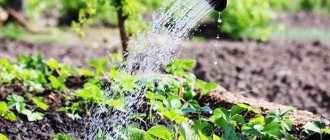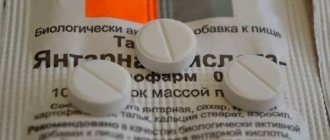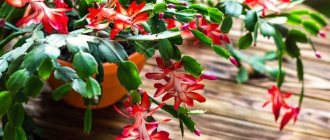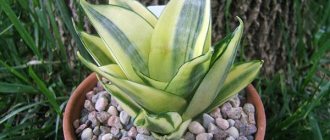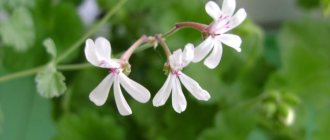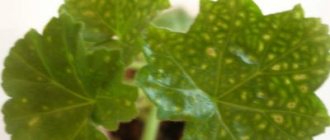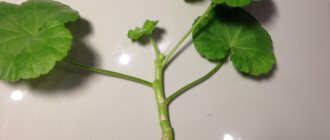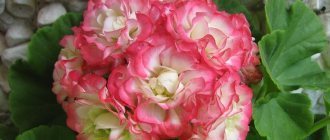Plants of the genus Pelargonium, like geranium, with which it is often confused, belong to the Geraniaceae family. Geraniums are perennial shrubs that grow in nature, and its heat-loving relatives are herbaceous perennials that have spread throughout the world from the tropics.
In northern latitudes, pelargoniums are grown as a houseplant. Flower growers love them for their easy care, long-lasting abundant flowering, and variety of colors and shapes of inflorescences. To flower, the plant consumes a lot of nutrients, so to maintain vitality it is necessary to regularly apply fertilizers, taking into account the characteristics of the species.
How to care for geraniums
Indoor geranium is considered an unpretentious flower, but for abundant flowering of geranium, you should follow the rules. Be sure to pay attention to the following points:
- Proper watering. Frequent watering of geraniums is not required; it is better to water rarely, but pour a lot of water. Optimally - twice a week. If you overdo it, mold will appear.
- Feeding. Geraniums need to be fed during the flowering period, as well as from spring to summer. Feeding with iodine is carried out. To do this, one drop of iodine must be diluted in a liter of water. Loves geranium and extracts with phosphorus. They are added during watering. And the application of nitrogen fertilizers is reduced to a minimum; it is better to apply mineral or organic mixtures.
- Loosening the soil. The earth is loosened several times a month, this helps prevent rotting of the roots, oxygen reaching the roots, and preventing the appearance of parasites.
- Transfer. It is done once every two years. Replanting is necessary because the roots grow and become crowded. Geraniums are transplanted into a larger container.
- Spring pruning. The flower wakes up from hibernation and needs to be pruned. If you prune in the spring, this will have a beneficial effect on flowering. During pruning, remove all yellow and damaged leaves and remove new shoots. Leave shoots with no more than five buds.
If you follow all the rules, geranium will delight you with lush flowering throughout the summer.
About the composition and dosage of fertilizers
The choice of fertilizing and application period is the key to the flowering and vital activity of pelargonium. For example, it is fed with organic matter only once every three years, since “oily” soil negatively affects the formation of buds - instead of flowers, the plant will delight with thick, brightly colored, juicy foliage. Mineral complexes are used several times a year, when and in what way depends on the season.
Pelargoniums, including the capricious royal one, are suitable for any complexes for flowering plants, but the composition must contain nitrogen, phosphorus, and potassium (N, P, R). Nitrogen is necessary for the formation of protein molecules - the basis of living organisms, the process of photosynthesis. If there is a lot (not enough), then, first of all, the foliage suffers. Phosphorus is needed by roots, potassium is needed for the absorption of carbon dioxide, the formation of buds, and immunity.
If there is a lack of potassium, buds do not set or the flowers are very small, but if there is little phosphorus, the foliage changes color. In addition to the main elements, other chemicals can be added in small quantities.
On the packaging of store-bought drugs, next to the letter indicating the chemical element, there should be a number indicating the concentration of this substance. For example, if the value is N2, P1, K2 or NPK 2-1-2, then the proportions are 2:1:2.
On a note! The best ratio of N, P, K for pelargoniums is 1:1:2. According to reviews from flower growers, fertilizers used for tomatoes are perfect for them. If there is more nitrogen, and it promotes the growth of green mass, this will affect the quality of flowering.
Complex fertilizers for pelargonium:
- “Agris Geranium” – N4, P3, K3 + sulfur, amino acids;
- "Agricola" - N15, P21, K25;
- “Master-agro” (sulfinia, petunias, pelargoniums) – N15, P9, K24 + MgO (magnesium oxide);
- “Osmokot” – N9-15, P9-12, K9-12;
- “Fertica luxury” – N16, P20, K27 + macro- and microelements;
- “Kemira Lux” – N16, P20, K
The addition of magnesium oxide helps the formation of a voluminous inflorescence with large bright flowers, a dense, stable peduncle, and improves immunity. In its pure form, magnesium has a positive effect on the processes of photosynthesis, helps the rapid absorption of phosphorus, and prevents chlorosis and necrosis of leaves.
The manufacturer specifies the dosage. If a smaller amount is required, it is convenient to use approximate proportions:
- 1 tbsp. l. – 20 g;
- 1 tsp. (a third of the dining room amount) – 7 g;
- 1 coffee spoon (a third of a teaspoon) – 2.3 g;
- on the tip of a knife – 1 g.
For example, the recommended dose is 20 g/10 l of water, but this is a lot, so it is enough to dissolve 1 g, that is, at the tip of a knife, in 500 ml of water.
The packaging also indicates how often to fertilize flowering plants. It is recommended to feed pelargonium every 7-10 days. For simplicity, you need to focus on the 1st (30th), 10th, 20th of each month, starting from February and ending in August-September.
Features of feeding geraniums
- When feeding, it is important to follow the dosage. If you add too many nutrients, the leaves will turn yellow and wilt.
- Nitrogen fertilizers for geraniums help it recover. They are added after pruning.
- Feeding geraniums for abundant flowering does not require special expenses. The main thing is to water the geranium with iodine dissolved in water, add a complex of minerals, observing the dosage.
You may be interested in: Treating the garden with iron sulfate in the fall, the pros and cons of fertilizer
Methods of application
At home, pelargonium is most often fed with nutrient solutions, since preparing them is not difficult - the dosage is indicated on the package. Calculating how many granules or crystals to add to one pot is difficult and you can make a mistake.
Foliar feeding for pelargonium is not suitable, since there are fibers on the surface of the leaf, and moisture is retained between them, which is undesirable.
How to use:
- Watering. On the day of watering, instead of ordinary water, use fertilizer diluted in water at room temperature. Water along the edge of the pot.
- Immerse the pot in water with a nutrient solution. Immersion time is 5 minutes, if the soil is dense, then about 10 minutes.
The soil must be moist when fertilizing so that the roots do not get burned. It is not recommended to fertilize a sick plant, in extreme heat, or if it is very cold.
Types of feeding geraniums
Spring feeding. As soon as pelargonium begins to wake up after a long winter, it needs to be fed. Fertilize geraniums with special mineral mixtures once every two weeks. Mineral mixtures can be purchased at the store. Also in the spring, organic fertilizers are applied, and a solution of iodine is used to feed geraniums.
Summer feeding. The geranium is blooming, during this period it needs to be fed for flowering. Fertilizing is carried out in the same way as in spring. The same fertilizers are used. Autumn feeding. Most varieties of geranium go dormant in the fall and winter; fertilizing is carried out until September. The frequency of fertilizing is reduced. Fertilizers are applied once a month.
Winter feeding. Geranium does not need feeding in winter. She is at rest at this time. Half the dose of nutrients should be applied in mid-winter.
For abundant and long-lasting flowering...
The first thing you should know is how to water geraniums so that they do not dry out and bloom profusely all year round, even in winter. Yes, such a miracle is possible if the plant is provided with a sufficient level of lighting and the application of a balanced mineral fertilizer. If you properly care for geraniums, its leaves will not turn yellow and the flowering will be very abundant and long-lasting. Some varieties, for example those with double flowers, are more demanding on growing conditions. Most pelargoniums do not like wet soil. They easily tolerate drought, so they develop more successfully in “forgetful” gardeners. Overmoistening of the soil leads to disease of the root system. For example, fungus develops under such conditions. Under the influence of such a microorganism, a perennial can die from gray rot.
Fertilizing with ammonia will help quickly increase leaf mass.
Before watering geraniums so that they bloom profusely in winter, you should remember a simple rule - at home this should be done quite rarely. A large amount of such moisture is used. Before watering, leave the water at room temperature for at least 1-2 days. Moisture is used warm. Fertilizers are periodically added during watering. Both ready-made formulations and mixtures prepared according to folk recipes are used as fertilizers. Thus, it became known that geranium responds well to fertilization with iodine, hydrogen peroxide and some other substances.
In order for geraniums to bloom all year round, fertilizing is necessary throughout the growing season - from spring to late summer. They are especially important when pelargonium gains color and blooms with lush inflorescences. Usually they use nutritional complexes with mineral elements purchased in flower shops. Before the plant begins to form buds, you can feed the perennial with nitrogen fertilizers. But there should be few of them. Geranium already grows and develops very quickly. Nitrogen before budding has a negative effect on flowers. The inflorescences become loose and the buds are smaller in size.
This is the result you can get after spraying a plant with succinic acid
How to feed geranium at home
It is not necessary to purchase expensive mineral fertilizers in the store. You can fertilize geranium at home with what everyone has in their home.
Hydrogen peroxide
It is necessary to make a solution: dilute 25 g of hydrogen peroxide in a liter of water. The plant is sprayed with this solution. This method is used when the plant is completely weakened. Treatment helps get rid of diseases.
Yeast for feeding
Yeast is used to strengthen the general health of the plant and accelerate growth. Once in the soil, the fungus stimulates the production of nitrogen and potassium. To prepare the fertilizer, add 1 gram of dry yeast to a liter of water. Water the plant with this solution. You can add sugar, this will only improve the effect.
You may be interested in: How to feed a money tree at home
Milk
Water the geranium with a milk solution (100 ml of milk per 1 liter of water), alternating with regular watering.
Glucose
Glucose solution is used for feeding during rooting of sprouts. But not all varieties of geranium love glucose; royal geranium does not require such feeding. If the geranium leaves have wilted, stop feeding. The supplement is prepared from a liter of water and a glucose tablet. Water the geranium with the solution.
Castor oil
Castor oil is necessary to stimulate the growth of any plant. Take a teaspoon of castor oil per liter of water. The mixture is carefully sprayed onto the leaves of the flower. You can pour the solution under the root. Oil should be applied during the flowering period or at the stage of bud formation.
When and what to feed
Plant activity depends on the time of year. Some are active all year round; in some, including indoor pelargoniums, all metabolic processes slow down with the onset of short daylight hours, i.e. they rest. Further stimulation can lead to the opposite effect and instead of strong shoots, weak, elongated shoots will grow.
To preserve the strength of the plant and prepare it for abundant flowering, complex fertilizers are not applied from September to February.
In the spring, formative and sanitary pruning is carried out and mixtures with nitrogen are needed to quickly restore shoots. Next, a large amount of nutrients is spent on the formation of buds, so phosphorus and potassium are needed. In August, next year's flowers are planted and iodine and hydrogen peroxide are added to the soil. In autumn the concentration is reduced and preparation for winter begins.
Table of feedings by month:
| Season, frequency | Feeding |
| Spring, every two weeks twice a month | March – azofoska or ammophoska (10 g/1 l) |
| April - like March | |
| May – superphosphate (5 g/1 l) | |
| Summer, every 10 days | June – potassium superphosphate (5 g/1 l) |
| July – potassium phosphate and azophoska (5 g/1 l each) | |
| August – iodine + hydrogen peroxide (1 drop of iodine + 20 ml peroxide/1 l) | |
| Autumn, one time | September – superphosphate (3 g/1 l) |
In October and until early to mid-February, water in smaller volumes; there is no need to fertilize.
How to feed geraniums for abundant flowering
Nutrition with iodine and manure
It is prohibited to introduce fresh manure. Feeding with this organic fertilizer can immediately destroy the plant. If pelargonium grows on a balcony or loggia, as well as in open ground in summer, you can add organic matter, but not fresh, and not more than once every 20 days. After such feeding, the flowers and leaves become strong and bright, the stem becomes stronger.
Regular watering is replaced by watering with an iodine-water solution. This will help the geranium begin to actively bloom and grow. Water can be replaced with rainwater, there are more nutrients there.
Nutrition with vitamins and nitrogen
How are fertilizers applied? Application rules must be followed:
- In early spring, before flowering, nitrogen fertilizers are applied. They must be paid once every 14 days. They improve leaf growth and bud formation.
- Vitamins are diluted in water. They can be purchased at the pharmacy. This will be cheaper than purchasing special fertilizer. The vitamin complex is changed every two weeks.
- Magnesium sulfate affects wild flowering. For nutrition, crystals of this chemical are dissolved in water, and the solution is used for irrigation.
- Increasing the amount of calcium in the soil is necessary if pelargonium grows and blooms poorly.
- The enrichment sequence is mandatory. Feeding is carried out during the flowering period and at the stage of bud formation.
Types of pelargonium and their features
Today, many varieties of pelargonium have been bred that can bloom both at home and in the garden when grown as an annual crop. Geraniums successfully survive wintering in open ground, so they are planted in flower beds as perennials, blooming from late spring until autumn.
The State Register of the Russian Federation includes floral and decorative representatives of three types of pelargonium: zonal, large-flowered and curly.
Zonal - the most famous and widespread, has more than 1000 varieties. The distinctive features of the plant are oval-carved leaves, thick stems with numerous lateral branches and spherical inflorescences on long peduncles.
Let's add to this a characteristic smell that causes panic in insects and headaches in overly sensitive people. The flowers range from simple to double, and are painted in a wide variety of shades. It blooms almost all year round, in the summer it feels great in the garden, in light partial shade, and in the fall the pot with the flower should be returned to the windowsill. The plant is easy to propagate vegetatively (cuttings) or seeds, which require prior scarification.
Plant height can range from 12-20 cm for dwarf forms to 60-100 cm for tall ones
According to the shape of the petals and buds, zonal pelargoniums are divided into rosebuds (Rosebud), star-shaped, carnation-flowered, tulip-shaped and cactus. In addition, there are variegated varieties that have very decorative foliage, painted in golden or bronze shades, with a border or a contrasting pattern.
Thanks to the efforts of breeders, the inflorescences have almost completely lost their resemblance to geraniums, turning into miniature “roses”, “tulips”, “carnations”
Large-flowered (royal) - from the name it is clear that the species is distinguished by large flowers, reaching 8 cm in diameter in some varieties. They are, as a rule, odorless, do not form spherical inflorescences, but are collected in loose clusters. The color of the petals is very diverse: monochromatic, two- or three-color. The leaves are hard to the touch, corrugated, with a serrated edge. Plants often develop in the form of a bush, with growing thin stems bending, which requires pinching the tops or tying them to a support. “Royal” ones are considered more capricious and more difficult to reproduce.
In open ground, large-flowered varieties can bloom all summer, and indoors (with proper care) - up to 9 months
Curly is an evergreen shrub from 40 to 70 cm in height with highly branched shoots that become woody over time. The leaves are small, hard, pale green, have curly edges and a pleasant lemon aroma. The flowers are small, borne singly or in inflorescences of 2-3 pieces. The color of the petals is usually pale, in pinkish-lilac shades. The plant prefers light, moisture-permeable soils with a neutral or slightly acidic reaction.
The flowers are simple (2-3 cm in diameter), appear on the bushes in July - August
Fragrant (fragrant) - has rather inconspicuous flowers, but the leaves are of particular value, emitting a pleasant aroma when rubbed or simply touched while passing by. Depending on the variety, the smell resembles citrus, mint, pepper, ginger, etc. The leaves have different shapes and colors, often openwork, with deep cuts. Lush shrubs grow in width and height (more than 1 m), but are not particularly decorative. The plant was originally bred to produce aromatic oils and essences, but today it is often grown on windowsills, used as a seasoning, and added to drinks and sweet desserts.
There are about a hundred fragrant varieties, they are divided into subgroups depending on the characteristics of the aroma
Ivy leaf (ampeloid) - perfect for garden decoration. It can be grown in pots (hanging flower pots, tall flowerpots) and in a flower bed as a ground cover. The stems are thin, creeping or drooping, with abundant branching. The leaves are similar to ivy: without pubescence, fleshy and smooth, slightly shiny, bright green or variegated, bronze. The flowers of most varieties are semi-double or double, the color of the petals is very diverse. Ivy-leaved pelargoniums are characterized by increased resistance to fungal diseases.
Numerous inflorescences, thanks to long pedicels, stand out well against the background of dense foliage
From a huge number of species and varieties, each gardener chooses the best ones that best suit the purposes and growing conditions. Despite the unpretentiousness of pelargonium, you need to understand that for abundant and long flowering the plant requires proper care, including regular feeding.
Features of geranium care
- Despite the fact that geranium is an unpretentious plant, you need to observe some nuances:
- The soil for geraniums must be fertile. Only then will pelargonium produce a maximum of flowers and a minimum of greenery. When transplanting, you need good drainage.
- There is no need to spray the flower. But it is important to provide the plant with fresh air. In summer, it is better to move the plant to the balcony, or you can plant it in a flower bed.
- Geraniums should grow in a well-lit place. She is not afraid of direct rays of the sun. Only on particularly hot days is the flower removed from direct contact.
- There are no special requirements for temperature. In winter, the optimal temperature is 15 degrees.
- The plant does not tolerate fresh organic matter.
- Iodine is ideal for plants as a fertilizer, but you should not apply more than 50 ml of it.
You may be interested in: Clematis: autumn care, feeding, pruning
Little trick
It often happens that a flower grows, but does not want to bloom. It seems that you water it on time and feed it, but it still does not please with lush flowering.
This is where castor oil comes to the rescue. In fact, many professional flower growers know this little trick. During the budding period, it is necessary to feed the plant. One of the best remedies is regular castor oil. Thanks to it, flowering becomes lush and long-lasting, flower heads become larger and the color is richer.
Feeding geraniums with yellow leaves
Pelargonium leaves often turn yellow; this can happen for various reasons:
- A transplant is required. The problem will disappear on its own after transplanting the plant into a large pot.
- Incorrect care. Pelargonium leaves may turn yellow due to drafts, too much moisture or too much temperature in the autumn-winter period.
- Lack of drainage. The leaves may turn yellow or even lose their color.
- Due to the large amount of nitrogen fertilizers, yellowness may appear on the leaves. Feeding with potassium-phosphorus agents is necessary.
Signs of improper fertilization
When using fertilizing, you also need to know the signs of plant behavior when there is a shortage or, conversely, an excess of any substance added to the soil. Let's look at the most common of them:
- Nitrogen. Excess nitrogen in the initial stages manifests itself in lush geranium vegetation and the almost complete absence of flowers. The stems become soft and loose, and the flower itself is very vulnerable to fungal diseases. Subsequently, the leaves turn yellow, become covered with brown spots and curl at the edges. With nitrogen deficiency, the growth and development of the plant slows down, the foliage becomes light green, and the stems become thin and fragile. Brown spots may appear on the lower foliage.
- Phosphorus. A large amount of phosphorus in the soil leads to a loss of the plant’s ability to absorb other useful substances, which disrupts metabolism. If there is a shortage, the root system stops developing and growing, the leaves dry out and fall off.
- Potassium. If there is an excess potassium content in the soil, there is a large delay in the growth and development of the plant, the leaves become dull and become stained. If there is a shortage, the foliage loses color, turns pale and may acquire a bluish-green color. The leaves begin to grow unevenly, lose their shape, and may be wrinkled or curled.
With very simple, but necessarily systematic and proper care, even a novice gardener will be able to enjoy lush and blooming geraniums, which will decorate any home with their appearance. At the same time, pelargonium is easily propagated, replanted and has a fairly long flowering period - all these qualities make this flower one of the favorite plants of gardeners.
How to feed geraniums when transplanting
Geranium does not like transplanting. Therefore, this should only be done when the flower has grown out of the pot. It is necessary to make a drainage layer in the new pot and choose the right soil. The soil must be loose and fertile. In the store you can buy soil intended for flowering plants.
The composition of the soil may include:
- Soil with peat and perlite additives.
- Layer of soil from the garden (top).
- Humus with sand.
No additional nutrition is required during transplantation. Feeding is carried out a couple of months after transplantation.
fertilizing, flowers
Yeast feeding recipes
To prepare the yeast infusion you will need water. It is better if it is soft and settled, without traces of chlorine. You can take spring or rain water. If you don’t have time to settle the liquid, you can pass it through a household filter. An essential component of the solution is wood ash. It helps to compensate for the deficiency of potassium and calcium that occurs during the life of fungi and the active processing of organic matter.
To create a nutrient medium for the yeast during fermentation, sugar is added to the water. The yeast itself must be culinary. Different types are suitable for the recipe: dry or raw. The only difference is the quantity of the product.
The feeding solution is prepared in two stages. First, make a concentrate by dissolving the yeast in water and waiting for fermentation to begin. The working solution is prepared immediately before application to the soil.
Feeding tomatoes with dry yeast, advice from experienced gardeners. Yeast is enriched with proteins, iron and other equally useful substances and acids. They are a great help for...
Recipe for fertilizing with raw yeast
Ingredients:
- 3 liters of water;
- 100 g granulated sugar;
- 100 g raw yeast;
- 1 cup wood ash.
How to cook:
Mix all ingredients in a large saucepan or five-liter jar. Leave the container in a warm place protected from light for four hours. It is important to avoid direct exposure of the yeast solution to ultraviolet light. The container is not tightly closed so that air can flow inside for fermentation. Before use, the finished concentrate is diluted by adding 40 parts of water heated to a temperature of +35 degrees to 1 part of the prepared solution.
Preparation of fertilizing from dry granulated yeast
A nutrient solution based on dry yeast is prepared according to the same principle. All components remain the same. The amount of dry yeast granules is reduced to 30 g. The fermentation time is also reduced by 1 hour.
The prepared solution cannot be stored for a long time. Fungal activity decreases noticeably the very next day. Therefore, it is better to prepare the solution right on the day of fertilizing. In this case, you need to take into account the number of plants and the volume of flower pots. For indoor geraniums, it would be appropriate to prepare a small amount of fertilizer. Therefore, the amount of ingredients, if necessary, is proportionally reduced.
Yeast fertilizers for tomatoes, how to dilute and apply. What did they fertilize beds with tomatoes in the old days? Some gardeners infused cut grass in water, others buried it in...
Recipe for bread and yeast sourdough
For variety, you can periodically replace the fertilizing prepared according to the classic recipe with a special starter. It is suitable for strengthening geranium seedlings.
Ingredients:
- stale black bread without traces of mold;
- 10 g dry granulated yeast;
- 200 ml yogurt;
- 100 g wood ash;
- warm water.
How to cook:
The bread is cut into small pieces and placed in a bucket, filling it halfway. You can use bread crusts instead of a whole loaf. Add the remaining ingredients and add warm water so that it covers the contents of the bucket. The container is tied with gauze on top and left in a warm place for 7 days. The mixture in the bucket is stirred periodically. Before use, the resulting fertilizer is diluted in half with warm water.
Vitamins
Fertilizer for geraniums so that they bloom can be purchased at the pharmacy. In addition to iodine, geraniums use B vitamins - B1, B6, B12. This is a folk remedy, one of the budget methods.
In the first months of spring, it needs nitrogen. Vitamins begin to be used closer to June. For one time use 1 ampoule of vitamin per 2 liters of water. Water the flower abundantly. Vitamins are changed every 3 weeks. Pelargonium can bloom well without fertilizers. The main thing is not to overdo it. Excessive amounts of added substances can destroy it. This feeding of pelargonium gives it the opportunity to bloom profusely and strengthens the plant’s defenses.
Mr. Summer resident informs: first aid for geraniums and prevention
Indoor geraniums with yellowed leaves can be saved. Tips for quickly helping pelargonium:
- when replanting, inspect the roots for rot or disease, if damaged, wash with a weak solution of potassium permanganate, and completely change the soil;
- a pot with a flower in autumn and winter is placed further from heating radiators, it can be taken out to a glazed balcony (if the temperature there does not drop below +12 °C);
- pour soft water over it, let it sit for a long time and add a pinch of citric acid or lemon juice (3-4 drops);
- constantly inspect for damage by insects and fungi, and take timely measures to get rid of them;
- the soil is chosen in the store; it is a universal soil for indoor plants;
- if the surrounding air is dry, do not moisten the pelargonium from a spray bottle; it is best to place a cup of water or wet expanded clay next to it;
- feed regularly, since the flower is sensitive to the lack of nutrients (choose complex fertilizers in the store);
- In order for pelargonium to bloom magnificently, pruning is done in the spring, leaving a few shoots;
- if the plant stretches to one side, the pot is turned to the sunny side with different sides;
- Before watering, loosen the soil; the root system of pelargonium needs oxygen;
- in winter, they carefully watch so that the leaves do not touch the cold glass, as a result they dry out, turn yellow and fall off prematurely;
- on a hot summer day on the sunny side, the window is shaded with a sheet of paper or a piece of gauze;
- if the window sill is cold in winter, to insulate the roots, place a wooden kitchen stand, a towel, and several layers of woolen fabric under the pot;
- if there is no drainage layer in the pot with geraniums, and replanting will not happen soon, then regularly pierce the ground in several places with a hot knitting needle;
- in winter, cover the batteries with a damp thick towel, this will get rid of the increased temperature in the room and too dry air for pelargonium on the windowsill;
- A good container for indoor geraniums is a ceramic pot. Porous clay allows air to pass through, excess water evaporates faster, and air flows to the root system.
Beautiful green leaves of pelargonium indicate the health of the plant and proper care. Changes in color indicate diseases, pests or bugs.
